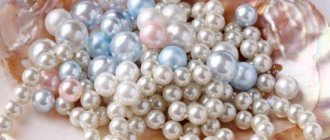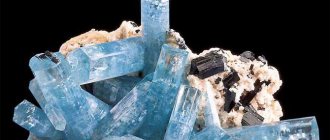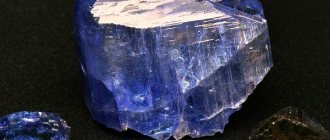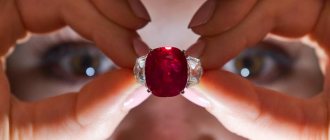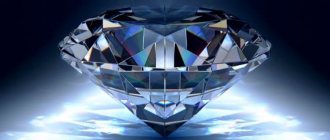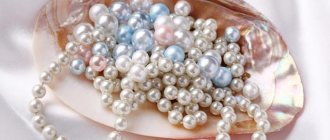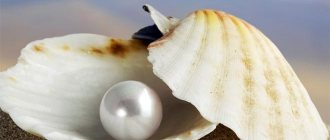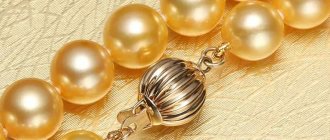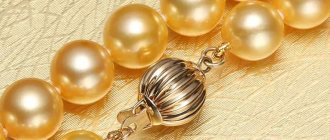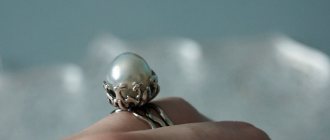Pearl jewelry never goes out of style. And let them say that it is old-fashioned and too traditional, but no one will refuse a gift in the form of a pearl necklace or a pair of earrings. What does the largest pearl in the world look like and how much does it cost? - a question to fill in, the answer to which will be interesting to know for any “why”.
Philippine nugget
Who would have thought that a real treasure in the form of a giant pearl would be hidden under the bed of a humble Filipino fisherman? And most importantly, he was absolutely unaware of the value of his find, which he accidentally discovered and raised from the bottom of the ocean. According to rough estimates, the cost of the pearl is about 100 million dollars. For ten years she lay in “obscurity”, acting as a kind of amulet. Before going out to sea, the fisherman touched it, believing in his luck.
The story would have remained unpublished if His Majesty Chance had not intervened. Due to the move, the young man had to give his talisman to his aunt for temporary storage. The weight of the pearl is almost 34 kg, its width is 67 cm, and its length is 30 cm. By coincidence, a relative worked in the tourism industry and, having seen such a “phenomenon,” persuaded her nephew to show the find to the local authorities. After examining the pearl by experts and recognizing its naturalness, it has every chance of being immortalized in the Guinness Book of Records.
The story of her discovery is surprising and banal at the same time. Going out to sea to fish, the future millionaire caught his anchor on some heavy object. Diving under the water, he saw a large mollusk, in which, after being lifted onto land and opened, the notorious pearl was discovered. It has a non-standard arched shape, resembling convex cartilage, but this fact in no way detracts from its value and natural beauty.
Peregrina ("The Wandering Pearl" or "The Wanderer")
“The Wanderer,” the older sister of Yusupov’s “Pelegrina,” can, without a doubt, be considered the most famous historical pearl. It was found in the 16th century off the coast of Panama. According to legend, a slave who was so lucky was rewarded with freedom. The first owner of the rarity was King Philip II of Spain. Then the pearl changed its kings and queens several times: Mary Tudor, Margaret of Austria, Napoleon's brother Joseph Bonaparte and Napoleon III, the Hamiltons... There is a known story that the latter lost the jewel twice - at a ball in Buckingham Palace and on the sofa of Windsor Castle. This is explained by the fact that the pearl was too heavy and simply fell out of all the settings.
Then times and queens changed - in the 20th century, Elizabeth Taylor owned the pearl. By the way, she also lost a piece of jewelry once in a room at the Caesars Palace Hotel. A historical pearl was found in the mouth of her beloved puppy. After this, the film star decided not to take risks. Together with the jewelry house Cartier, Elizabeth herself came up with the design of a unique pearl and diamond necklace, the main decoration of which is La Peregrina. After the actress's death in 2011, this beauty was auctioned for $11.8 million.
Pearl of Allah
In 1934, an amazing pearl was found near the island of Palawan, located in the waters of the South China Sea. It was impressive not only for its size, but also for its shape, which outwardly resembled the convolutions of the human brain. Until recently, it was considered the largest in the world, receiving the symbolic name “Pearl of Allah”.
Interestingly, the weight of the shell in which the precious “cargo” was matured was 300 kg. The diameter of the find is 23.8 cm, and weighing showed 6.37 kg.
As often happens, a happy occasion is always preceded by some misfortune. This happened with the “biography” of the Pearl of Allah. It was discovered by a young fisherman who, through negligence, accidentally put his hand into the opened shell of a giant tridacna. The mollusk slammed the doors shut, and the hand remained hostage to the trap. It was not possible to save the guy, and when his body was raised to the surface and the shell was opened, a real miracle was revealed to the eyes of the fishermen. The pearl received its unusual name because of its resemblance to a human head dressed in a block of wood.
In addition to the real story, there is also a beautiful legend associated with the ancient Chinese philosopher Lao Tzu. It tells that the thinker carved three faces from stone: his own, Buddha’s and Confucius’s. The “models” were then placed in individual pearl shells and covered with natural mother-of-pearl over the course of several years. Once the pearls reached a certain size, they were transplanted into other shells, passed on from generation to generation. During the next transportation to a new place, one of them was lost during a storm near the Philippine Islands. It was precisely this that the young fisherman found after giving up his life. According to this legend, the jewel received a second name - the Pearl of Lao Tzu.
But no matter how poetic the legend may sound, scientists have smashed it to smithereens, claiming that the real age of the pearl is no more than 600 years. While the events described by the philosopher, and the life of Lao Tzu himself, date back to 400 BC. The estimated value of the treasure is about 400 million dollars. Its current owner is Victor Barbish, who bought the treasure from American jeweler Peter Hoffman several decades ago.
There are rumors that in the 90s Bin Laden himself wanted to purchase it for his collection, offering $60 million as a ransom. The relic is kept in one of the US banks, whose name is not disclosed for security reasons. All that is known is that the owner of the pearl is going to bequeath it to some famous museum. Then everyone will be able to see with their own eyes what beauty nature can create.
Peregrina ("The Wandering Pearl" or "The Wanderer")
“The Wanderer,” the older sister of Yusupov’s “Pelegrina,” can, without a doubt, be considered the most famous historical pearl. It was found in the 16th century off the coast of Panama. According to legend, a slave who was so lucky was rewarded with freedom. The first owner of the rarity was King Philip II of Spain. Then the pearl changed its kings and queens several times: Mary Tudor, Margaret of Austria, Napoleon's brother Joseph Bonaparte and Napoleon III, the Hamiltons... There is a known story that the latter lost the jewel twice - at a ball in Buckingham Palace and on the sofa of Windsor Castle. This is explained by the fact that the pearl was too heavy and simply fell out of all the settings.
Then times and queens changed - in the 20th century, Elizabeth Taylor owned the pearl. By the way, she also lost a piece of jewelry once in a room at the Caesars Palace Hotel. A historical pearl was found in the mouth of her beloved puppy. After this, the film star decided not to take risks. Together with the jewelry house Cartier, Elizabeth herself came up with the design of a unique pearl and diamond necklace, the main decoration of which is La Peregrina. After the actress's death in 2011, this beauty was auctioned for $11.8 million.
Types of pearls
There are two main types of pearls - sea and freshwater. Since sea water is richer in its chemical composition than river water, the pearlescent secretion formed around the pearl “base” looks much brighter and richer. Pearls have not been mined naturally for almost half a century - this is prohibited by international law. To grow shells, special farms located in tropical seas are used.
It is possible to distinguish between sea and river “material” with an unprofessional eye. It is enough to carefully examine the shape, color and level of brilliance of the pearl.
- It is almost impossible to grow a perfectly round pearl. However, sea pearls are as close to ideal as possible, but river pearls, on the contrary, have more elongated roundness, reminiscent of an egg or an oval. The relief of the outer shell also differs. In freshwater pearls, as a rule, it is uneven, covered with tubercles and dents, while in sea pearls it is even and smooth.
- What distinguishes freshwater pearls from sea pearls is their shine. The first one looks dull in the light and has a matte tint, while the second one shines and shimmers in the sun, “showing off” its mother-of-pearl. This effect is achieved due to the special composition of sea water, containing a high percentage of salt. During maturation, the pearl is polished in an alkaline environment, resulting in a characteristic pearlescent luster.
- Freshwater pearls are smaller in size than sea pearls, averaging 6-8 mm in diameter. The ripening period also passes faster - about 2 years, and accordingly the price per gram is set lower.
- You can distinguish sea and freshwater pearls by their color. The first one does not shine with transitional shades, but you can find black and hot pink “models”. The second has a much richer range of colors - light cream and brown to olive and lilac-lilac. The coloring of freshwater pearls often has a fragmented appearance, while sea pearls are evenly colored and have no color flaws.
- The longevity of the “inhabitants” of seas and rivers also varies. Everything here is like with people. Freshwater pearls that are more hardened in cold water have increased wear resistance and do not lose their appearance for many years. But marine aristocrats, raised in the warm tropics, are very vulnerable to external conditions and can quickly lose their luster under intensive use. If the beads inherited shine, as they did many years ago, having begun their “story” on my grandmother’s neck, then this is guaranteed to be river material.
What determines the color of pearls
The tonality of a stone is determined by three factors:
- main tone - the predominant color;
- additional (overtone) - a less intense shade that is visible when light falls on the surface;
- reflection - a glow coming from the depths.
An additional tone can play and shimmer in several shades, but the main tone will always be much richer. This is how the color is determined.
The color of pearls is influenced by several factors. First of all, this is the type of oyster and the color of its mantle, as well as the habitat or location of the farm where the cultivation takes place. The temperature of fresh or sea water and its composition are important.
Due to the manganese content in the water, pearls grown in India are pink in color. Blue and green stones are from Indonesia. Minerals of gold and brown tones are characteristic of Mexico, and white - of Japan. Farms that cultivate pearl beads usually add special substances to the water to obtain the desired shade.
The color of minerals that have bumps may be or appear uneven (the depressions are slightly darker). In this case, a more careful analysis is needed.
Interesting facts about pearls
They say that Queen Cleopatra once argued with Mark Antony, promising to make the most expensive cocktail from ordinary wine. She dissolved a large pear-shaped pearl in a glass and drank it in one gulp in front of the amazed admirer. The dispute was won.
Here are some more interesting facts related to pearls:
- In total, there are 8 pearl configurations: oval, pear, button, semicircle, drop, circle, sphere and arbitrary irregular shape.
- Marie de Medici, Queen of France, was very fond of wearing pearls and had one special dress in her wardrobe. It was all embroidered with jewelry, of which there were about 30 thousand pieces.
- On the territory of ancient Rus' there were more than 50 rivers where pearl fishing was carried out. It was mainly concentrated in the northwestern part of the country.
- It is a rare occurrence when there are two pearls in a shell at once. An example of natural “magic” was the discovery of nine pearls at once, fused with each other in a cross shape and called the “Great Southern Cross”.
- Coco Chanel elevated pearls to the rank of classic jewelry. With her light hand, he came into fashion, becoming certainly associated with the little black dress. As the great fashion designer said, pearls are always right.
Pearls by Pierre Cartier: $1 million
In 1917, Pierre Cartier, one of the famous French jewelers, started his business in a new office in New York. Plant owner Morton Freeman sold him the office for just $100 and a small two-strand pearl necklace that Plant's wife really liked.
For a very long time, Pierre Cartier made and sold pearl beads. In 1910-1920 they reached very high prices, about the same as the prices of famous paintings by famous old masters. Thus, the famous Pierre Cartier necklace, consisting of 55 and 73 pearls, was sold for $1 million.
Pearl "Beauty of the Ocean": $139 million
In 2010, a very rare and expensive pearl was presented in China. "Beauty of the Ocean" weighs six tons. This is the largest artificial pearl in the world. The fluorite pearl took three years to create and tends to glow in the dark . Discovered in Mongolia, the rare and precious pearl is valued at $139 million, making it the most expensive pearl on the market.
"Big Pink Pearl": $4.7 million
This natural auricle-shaped pearl was discovered by diver Wesley Rankin in 1990 and weighs 470 carats (94 grams). Its uniqueness is that it shimmers in many colors: silver, orange, pink, green, blue and lavender.
The "big pink pearl" was valued at $4.7 million in 1991 and is still in Rankin's possession. He is the owner of , based in Petaluma, California.
